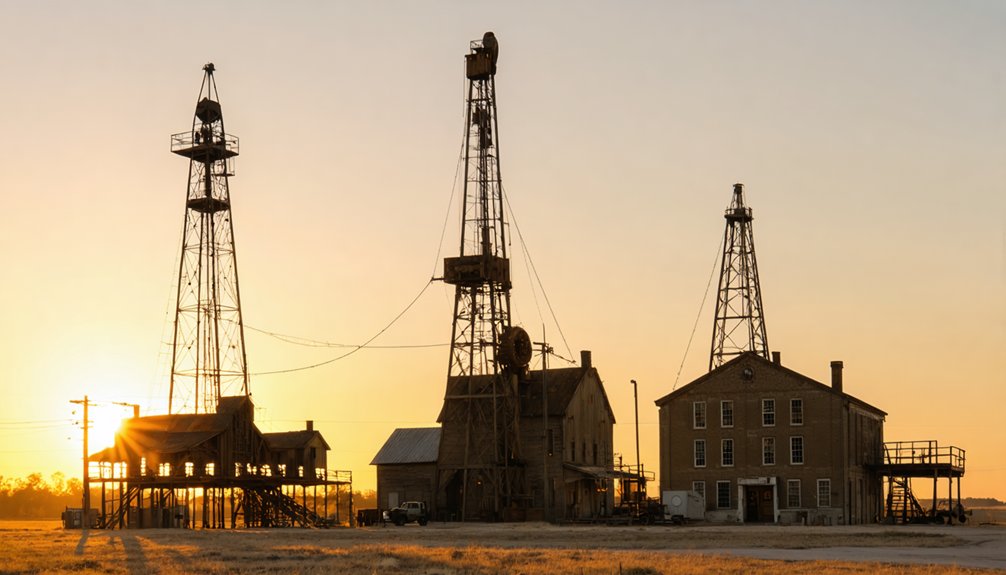You’ll find America’s overlooked oil towns in Bradford, PA, where the nation’s first giant oil field still produces specialized crude; Arvin and Benicia, CA, where Latino communities leverage environmental regulations against industry impacts; and Abbeville, LA, which demonstrates remarkable economic resilience through diversification strategies. These three communities illustrate distinct aspects of petroleum’s influence on local economies, environmental activism, and industrial adaptation. Their stories reveal vital insights into America’s complex energy landscape.
Key Takeaways
- Bradford, PA transformed from a lumber town into America’s first giant oil field, producing over 681 million barrels since 1864.
- Arvin, CA demonstrates how Latino communities use air protection laws to combat health issues linked to oilfield operations.
- Abbeville, LA exemplifies economic resilience through diversification across manufacturing, agriculture, and professional services during oil’s boom-bust cycles.
- These overlooked towns showcase different oil industry adaptations: specialized production, environmental activism, and economic diversification.
- Each town’s approach reveals strategies for balancing economic sustainability with environmental health and community well-being.
Bradford, PA: Historical Heritage Meets Niche Oil Production
While often overshadowed by more prominent petroleum centers, Bradford, Pennsylvania stands as a cornerstone of American oil heritage with strategic relevance in today’s specialty lubricant market.
You’ll discover the birthplace of America’s first giant oil field that produced over 681 million barrels since 1864, once supplying 83% of U.S. oil output. Bradford’s legacy transformed a lumber town of 600 into a 42,000-strong boomtown, driving national industrial expansion.
The refinery’s oil innovation continues today, processing 9,000 barrels daily of Pennsylvania Grade crude. The extensive waterflooding techniques implemented throughout the 20th century ultimately led to declining production by the 1990s.
When visiting, don’t miss the Penn Brad Oil Museum chronicling the technological advancements that revolutionized the industry, including the pioneering 10W-30 motor oil introduced in 1953.
This continuous operation represents Bradford’s resilience in maintaining relevance through specialized production despite changing market dynamics. The town’s oil legacy began with the historic Jackson Walker Well that erupted in 1875, inspiring the founding of Kendall Motor Oil.
Arvin and Benicia, CA: The Rising Tide of Environmental Activism
Unlike Bradford’s shift to specialized production, Arvin and Benicia, California exemplify how environmental activism has fundamentally restructured oil town dynamics in regions with significant petroleum infrastructure.
You’ll find Arvin’s largely Latino population leveraging California’s community air protection laws to address poor community health outcomes tied to oilfield operations. Their 2018 ordinance establishing stringent local regulations for new wells represents a market-disrupting departure from Kern County’s industry-friendly stance.
Meanwhile, Benicia’s successful rejection of Valero’s crude-by-rail project demonstrates how informed citizenry can recalibrate the traditional power balance between industry and municipality.
Both towns showcase a strategic model where community organizations deploy regulatory frameworks to counter economic pressures, creating templates for petroleum-dependent communities seeking environmental autonomy amid declining production profiles. Arvin’s activism emerged partly in response to having air quality among the worst in the United States, directly attributable to nearby Edison Oil Field operations. The Committee for a Better Arvin has focused their advocacy efforts on the oil and gas industry after residents reported high rates of respiratory illness and cancer in their communities.
Abbeville, LA: A Model of Economic Resilience in Oil Country
When examining the petroleum landscape across rural America, Abbeville, Louisiana emerges as an instructive case study in economic sustainability within volatile energy markets. Unlike many single-commodity towns, Abbeville has successfully navigated oil’s boom-bust cycles since Continental Oil’s 1937 discovery through strategic economic diversification across manufacturing, agriculture, and professional services.
The town’s resilience metrics outperform comparable municipalities by leveraging offshore exploration advantages without excessive dependency. Following Hurricane Katrina’s devastation in 2005, local businesses demonstrated remarkable recovery capabilities while maintaining connections to regional energy infrastructure. Abbeville residents have experienced the historical oil bust of the 1980s that devastated many Louisiana parishes, yet managed to maintain economic stability through diversification. Producers maintain respectable output—approximately 0.14 million barrels annually—while service operations create employment stability through regional networks.
This economic framework is reinforced by community support systems that buffer income variability. Families tap informal networks during downturns, deploying adaptive strategies that mitigate volatility.
Abbeville’s model presents actionable insights for resource-dependent communities seeking liberation from extractive industry dependence.
Frequently Asked Questions
How Do Smaller Oil Towns Attract Younger Skilled Workers?
You’ll find these opportunity-rich municipalities leveraging remote work flexibility, premium wage growth (5-10% above average), community engagement initiatives, targeted vocational training partnerships, and deliberate economic diversification strategies to capture your professional aspirations and market value.
What Healthcare Challenges Exist in Oil-Dependent Small Communities?
You’ll face restricted healthcare accessibility and inadequate mental health services due to provider shortages, infrastructure deficiencies, and market volatility—compounded by transportation barriers that limit your medical autonomy in these resource-constrained environments.
How Do Oil Towns Manage Boom-Bust Cycles Financially?
You’ll optimize fiscal resilience by building substantial rainy day funds, implementing conservative revenue projections, and prioritizing economic diversification investments during boom periods to mitigate inevitable market contractions when commodity prices decline.
What Cultural Preservation Efforts Exist Beyond Oil Heritage?
You’ll find communities leveraging cultural festivals and local museums to preserve agricultural traditions, architectural heritage, ethnic celebrations, and indigenous knowledge—diversifying their economic portfolios beyond petroleum-dependent market cycles while liberating residents from mono-industry vulnerability.
How Are Schools Funded in Declining Oil Production Areas?
You’ll find school funding deteriorating as oil revenues contract, with heavy reliance on declining property taxes, insufficient state equalization formulas, and diminished severance tax proceeds—creating market-contingent budget vulnerabilities that restrict educational autonomy.
References
- https://badassworkgear.com/top-us-oil-towns/
- https://espis.boem.gov/Final Reports/3415.pdf
- https://grist.org/article/small-california-towns-are-facing-off-against-oil-companies-and-winning/
- https://www.govinfo.gov/content/pkg/GOVPUB-I-9af877e9be6c7bb9fc2bf7e879448e2d/pdf/GOVPUB-I-9af877e9be6c7bb9fc2bf7e879448e2d.pdf
- https://www.alleghenyfront.org/inside-the-world-of-small-oil/
- https://biotech.law.lsu.edu/blog/vol5.pdf
- https://www.visualcapitalist.com/mapped-u-s-oil-production-by-state-2/
- https://commons.und.edu/cgi/viewcontent.cgi?article=6232&context=theses
- https://jpt.spe.org/small-california-town-takes-oil-industry
- https://en.wikipedia.org/wiki/Crude_oil



